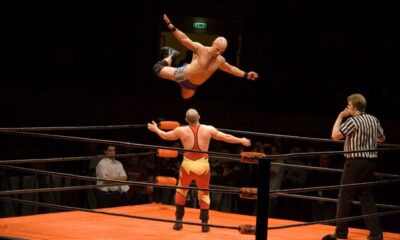
Wrestling might have been around since the Ancient Greeks, but there’s still a lot that people don’t know about it. That includes the fact that there are several types outside of the pioneering freestyle Olympic wrestling we often see on television.
If you are looking to get into wrestling, it’s crucial to educate yourself on all the types being practiced around the world. So, without further ado, let’s discuss the different wrestling practices across the globe.
What Are the Different Wrestling Types?
Wrestling isn’t just about jumping, running around, and making a spectacle of the moves one uses to take down an opponent. It can also be about culture, discipline, and fitness. These are but a few of the many aspects of the following wrestling forms:
1. Freestyle Olympic Wrestling
There are two wrestling forms with Olympic representation, and this is one of them. Widely practiced around the world, its objective is to throw and pin an opponent against the mat. Whoever achieves this is declared the winner.
This form allows fighters to use their legs for both defensive and offensive tactics. There’s a move called the scissor hold, where one holds an opponent to the ground using their legs in an effort to get them to submit. Tripping is also perfectly legal in this wrestling type despite how dirty it may seem.
2. Folkstyle Wrestling
Among the wrestling types taught in American schools is folkstyle wrestling. It is often called scholastic wrestling and comes in several different versions, depending on the university it’s taught in. Colleges use it as a way for all levels to improve their fitness.
Freestyle and folkstyle wrestling aren’t much different. They both involve the defensive and offensive use of the lower body in matches and focus on the dominance aspect to gain the win.
3. Greco-Roman Wrestling
Of course, the wrestling industry has done well to pay dues to its origins: Greeks and Romans. The Greco-Roman form of wrestling is the second type represented in the Olympics and one of the very first to feature in the modern version of the games in the late 1800s.
A few key differences from freestyle wrestling led to this wrestling form having another category named after it entirely. Unlike its counterpart, it doesn’t allow for holding below the opponent’s waist. And tripping, which is a legal move in freestyle, is disallowed.
That means techniques for Greco-Roman wrestling revolve mainly around throws. For this reason, Greco-Roman wrestlers are typically built heavier and are more powerful than those practicing other disciplines.
4. Sumo Wrestling
To participate in sumo wrestling, one has to hold considerable weight. Fighters in this category easily go over 300 pounds and develop their techniques where the truly authentic sumo wrestling schools are, Japan. Aside from tactic-honing, these establishments also hone one’s physique through the proper training, eating, and resting cycles.
Bulk is where sumo wrestlers impress immensely. You see them looking massive and majestic in their tiny trunks held by the belts around their waist. The scene can be riveting, especially when these big guys start to square off.
The wrestling match starts with the two fighters charging at each other. This is done in an effort to push the opponent outside the ring, which would then earn a wrestler victory. A win can also be scored when one gets his opponent to touch the ground with a body part other than his feet. Hence, sumo wrestlers don’t simply have to be big and strong; they have to be agile and nimble, as well.
5. Cumberland Wrestling
In Northwest England, a form of wrestling showcased in agricultural shows remains prevalent. It’s called Cumberland wrestling and is styled slightly differently, depending on the English county it hails from.
Cumberland wrestling is something akin to Icelandic wrestling, which originated in Glima. Like this Norse version of the sport, it has Viking influences apparent in its techniques and movements.
The back hold already gives a hint of that old Norse influence. You can see it the way the wrestlers start squaring off with each other, chest against chest. They then wrap their arms around one another, their chins on either side of the opponent’s shoulder.
Which Type of Wrestling Suits You?
So, there you have it: five types of wrestling practiced by different people and cultures. The Olympic Games may have made popular freestyle and Greco-Roman forms of wrestling, but they aren’t the only versions you can practice.
Although, we strongly advise that once you pick a specific wrestling path, stick to it. You should also secure fighting equipment necessary for a safe and smooth-progressing journey. After all, these are profound sporting disciplines that take years to master and can take their toll on your body when practiced incorrectly.















